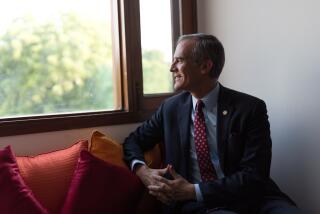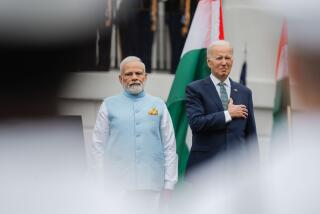Power of the Market Raises India’s Star in U.S.
- Share via
WASHINGTON — If symbols define politics, then India’s Independence Day celebrations in Washington on Aug. 15 spoke volumes about the changing profile of U.S.-lndian relations. Flanked by Secretary of State Madeleine K. Albright and Commerce Secretary William M. Daley, First Lady Hillary Rodham Clinton announced to some 1,300 assembled Indian Americans that President Bill Clinton would soon visit the subcontinent. For a region notably absent from official travel schedules, the president’s trip--and, separately, those of Albright, Daley and a raft of deputies--suggests renewed interest in a country whose relations with the United States have often been testy.
India’s rising estimate in the United States probably illustrates more about the America than about India. Mercantilism now tints U.S. diplomacy, and the bigger the trading market, the brighter our diplomatic colors. Even if current figures are exaggerated--India claims its growing middle class is close to 200 million people--consumer potential is enormous. Moreover, educated, prosperous Indians have become significant business partners: Since serious economic reform began 10 years ago, foreign partnerships have extended and diversified across the business community. India not only trades but also produces--for the West, as well as Asia and Africa.
To Indians, this is no surprise: The increasing world interest simply vindicates their long-term (if occasionally changeable) policies and plans. Since independence 50 years ago, India has worked doggedly to create a place for itself in the world. Its leaders, regardless of political stripe, have consistently sought to anchor India’s economy and security in an international setting. Its ambitions are no less than a great power’s: a seat at the table when the world’s affairs--money, development, war, weapons--are discussed.
But these aspirations accompany serious liabilities, for India, its interlocutors and its partners. India represents bundles of contradictions, as most travelers quickly note: a half-billion poor living alongside the nascent rich; an agricultural economy that can feed most of its population but no longer supports its farmers; far more trained job-seekers than jobs, creating a labor market that feeds exasperation and political extremism; a cumbersome bureaucracy that often stifles the same entrepreneurs whose efforts should ground economic prosperity, and a highly militarized state whose value is, in an era of prospective peace, contestable.
The old India--impoverished, famine stricken, sharply assertive--is slowly being replaced by a new India with more rounded edges. The distinction is never fully clear, however; no development process is completed overnight. It is a changing India--neither new India nor old, neither black not white, but the India of contradictions and many, many gray areas--that compels our attention. For in its contradictions lies the success or failure of renewed U.S. engagement.
Washington has not really been listening to the complexities that comprise India, and its deafness is dangerously selective. When the United States responds to India’s bywords of democratic secularism, it willingly ignores resolute class problems that pervade its society and economy. When the U.S. gleefully embraces businessmen who speak the language of Wall Street, it assumes the old socialism is dead and the detritus of the centralized state will soon wither away. Not so. Centralism has played a critical role in India’s development, and until the state’s constituencies can be satisfied differently, India’s unique mixture of money and militarism will almost undoubtedly continue.
First, the ideology of the old India was socialism, and with it came a large state and concentrated central power. This structure outlived its usefulness and created industrial behemoths that still resist change as much as India’s bureaucracy. But ideology doesn’t die with the first breaths of reform. Indeed, the enduring legacy of old India is not the fact of socialism, but its promise of equity.
For the vast army of the poor whose sheer numbers can sink future profit centers, this promise is sacrosanct--even if they have given up on corrupt politicians who rarely deliver on familiar slogans. Disputatious politicians and dominating bureaucrats still know the pulse of the poor, who understandably fear the indifference of unfettered capitalism. Until this unevenness is leveled, old ideologies will endure, the promise of profit will be limited and the bureaucratic state will surely survive.
Second, India’s large, modern and assumedly nuclearized military, whose primacy is rarely contested, draws its authority from two separate impulses: insecurity about national borders and a sense of regional, if not international, destiny. Border insecurity is gradually diminishing: Fears about China seem quelled for the moment; relations with Bangladesh and Nepal, achieved by diminishing old hegemonic impulses, seem smoother as well. The Pakistan border and the festering sore of Kashmir, however, continue to impede regional stability and domestic peace.
These are the places where internal and external politics meet: with hundreds of thousands of security forces along the Kashmir and Pakistan borders; regular armed incidents between the Pakistani and Indian armies, and police actions against insurgents in Kashmir. India’s profile along its northwest frontier is militaristic and, in Kashmir, far from democratic.
Destiny is more difficult to qualify, particularly when nuclear weapons are involved. India’s nuclear arabesque with the West highlights fundamental incompatibilities between U.S. nonproliferationists and India’s nuclear establishment. India refuses to curtail its program until the rest of the world, including the U.S., does too. It considers itself a member of the nuclear club--not a supplicant to its arbitrary rules. Washington has been unable to resolve this stalemate--and equally unable to arbitrate disputes between its in-house nonproliferation advocates and its India promoters, who envision shared profits and, perhaps in the distant future, some form of nuclear control in the subcontinent.
The lure of Mammon may settle this wrongheaded dispute--Washington is far more interested in India’s economy than in repetitive nuclear debates. But this choice entails significant cost. India is right to dispute the rules of the nuclear game, but only if it will subject itself to new ones--a debatable proposition. India’s future role in Asian security will depend on establishing new trust with its neighbors and the West, and this, too, depends on keeping its nuclear word.
But India’s demand for greater voice--backed by increasing economic muscle--nonetheless echoes our own discussions about the responsibilities of power today. India’s policies and practices remind us that superpower politics may be evanescent and, more important, that the club of global decision-makers must be expanded if peace is to prevail in the next century.
Politics remains the art of the possible--for India’s President Kocheril Raman Narayanan as much as for Clinton. If anything has changed in U.S.-Indian relations, it is, at least for the moment, a new sense of possibility. But for possibility to be realized, both sides will have to think more clearly about their long-term interests--by replacing lectures with more acute listening, and the simplicity of bilateralism with nuanced internationalism. Only then can partnership begin.
More to Read
Get the L.A. Times Politics newsletter
Deeply reported insights into legislation, politics and policy from Sacramento, Washington and beyond. In your inbox twice per week.
You may occasionally receive promotional content from the Los Angeles Times.










